Fleeing War
These women all have two things in common: they make barely enough money to survive and they are all refugees who fled the war in Northern Uganda. After suffering a decade or more of war in Apac district in Northern Uganda, they came to Kampala in search of a safer and happier life. Most have now spent over a decade working at the quarries with no respite.
Grace Lamono is one such woman. She works at the stone quarry with her young daughter and leaves her other children at home alone while she spends dawn to dusk in the pits.
Before the war, Lamono’s life was very different. She attended school in Pamolo, a small village in Apac district, Northern Uganda, until she was 16-years-old. When her father died she quit school because her family no longer had enough money to pay school fees. Soon after, she married and had three children. She lived with her husband and worked as a subsistence farmer, feeding her family the cassava, millet, beans and mangoes she grew in her fields.
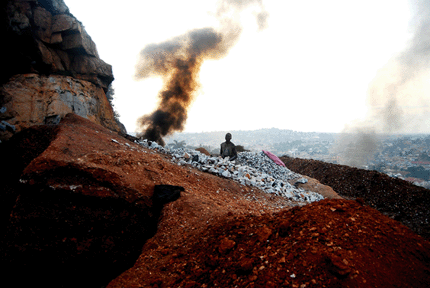
[Photo: The women work in terrible conditions at the stone quarry. Dust and small particles of rock get stuck in their throat and there’s a constant cloud of black smoke emerging from the burning pits.]
In 1994, the Lord’s Resistance Army (LRA), a guerrilla force fighting for their millenarian ideals against the Southern-based Ugandan government, attacked. They raided her village, rounding up hundreds of people in huts and set them on fire. Lamono, her husband and her children were one of the few families to escape.
Grace and her family fled to Kampala. When they arrived in Uganda’s capital city, her husband immediately returned to pick up supplies they had left behind when they rapidly departed. She hasn’t heard from him since and believes he was abducted by the LRA.
Left with no other option, Lamono began working at the quarry. Having arrived in Kampala with three young children, all under the age of 10, and without community connections, friends, a husband or an extended family, she had to take the first job she could find.
Fourteen years later, Lamono’s back is slowly being crippled by hard, unending work; her 11-year-old daughter, who also works at the quarry, has a severe infection; her eyes are red, puffy and running. Neither expect to leave the quarry: Lamono’s children will probably take up their mother’s tools once Lamono is bedridden and remain confined to the harsh cycle of poverty.
The Urban IDP
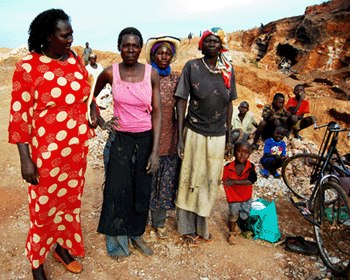
As the LRA raids became more frequent in rural Northern Uganda, the Ugandan government established Internally Displaced Persons (IDP) camps where they could protect villagers cut off from all communication and the army’s protection. Over a million people settled in these camps where they received inadequate but regular meals and health care.
Since the raids stopped in early 2007, the United Nations Office for the Coordination of Humanitarian Affairs (UNOCHA) says that over half a million people have returned to their former villages. These rural IDPs have benefited from government resettlement schemes, like the Peace, Recovery and Development Plan launched in 2007, and many have received compensation and assistance helping families start anew.
But Lamono and the women working at the Kireka stone quarries, as well as the 300,000 to 400,000 other urban IDPs spread out around Southern Uganda, who are called ‘urban IDPs,’ have largely been excluded from any resettlement plan or humanitarian aid despite the fact that they are legally entitled to assistance under Uganda’s national policies for IDPs. During a recent cholera outbreak, few received the same level of assistance and health care that rural IDPs receive in camps supported by the United Nations High Commissioner for Refugees (UNHCR) and the World Food Programme.
On top of this, they’ve been forced into living conditions that they are not used to. Moses Okello, head of the Research Department with the Refugee Law Project (RLP), a local non-governmental organization (NGO) that assists refugees in Uganda, explains, "[Urban IDPs] are a rural population suddenly forced to eke out a living in an urban setting their coping mechanisms are going to be severely stressed."
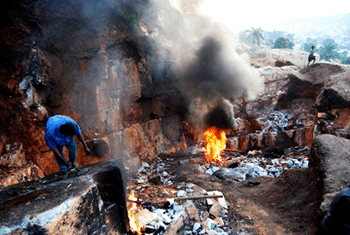
Many of the women at the Kireka quarry want to return home, as do most other IDPs. Previously, they lived among their families and benefited from a small and supportive community. Today, they live in a ghetto aptly called the Acholi Quarters (Acholi being their ethnicity). They struggle everyday for survival and wonder what happened to their husbands and children. They are not equipped with the necessary skills to barter and argue their way in an urban environment where they’re largely cut off from family and community connections.
The women also live in appalling conditions – worse than in the IDP camps once called the worst humanitarian disaster in the world. A woman will live in one room with her five children. She’ll use the room for sleeping, washing and cooking. "The kitchen utensils are pushed under beds to make room to sleep at night," describes Beatrice Okeny, the director of the Northern Ugandan Women and Children Initiatives (NUWECHI), one of the few local organizations that assists the women, "there is no electricity, the floors aren’t cemented and their ceilings aren’t plastered . . . four families have to use one pit latrine with just a potato sack covering the door."
Okeny points out that resettlement will be costly. The women will need money to travel back to their villages, to rebuild their huts, to rent places during the reconstruction, and to buy seeds and food during the months before harvest. It’s not simply a get up and go procedure, she explains.
A Pandora’s Box
Despite the legal requirements to assist IDPs no matter where they live, Okello says the Ugandan government has largely ignored the urban IDP dilemma. RLP "literally dragged" the State Minister in Charge of Disaster Preparedness and Refugees, Musa Ecweru (who has been accused of defiling a 17-year-old girl), to see the situation in Kireka. While Ecweru did promise to provide food and transport for return purposes, Okello sees this as a "welcome, albeit token gesture."
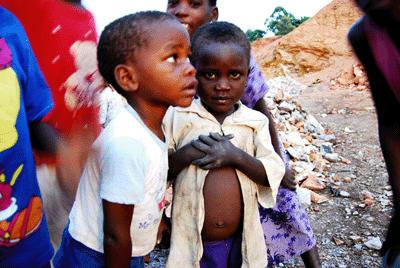
[Photo: Children at the stone quarry. Most mothers can’t afford to send their kids to school on a regular basis. The kids often spend their days playing in the quarry pits, and, when they’re old enough, working.]
Okello says that some progress was recently made when the UNHCR, the UN refugee agency, suggested "a profiling exercise" to help NGOs and the government in Uganda better understand the situation of urban IDPs. But, he says the Ugandan government stopped the procedure claiming that the Office of the Prime Minister did "not have a position on urban IDPs."
"The reluctance to help urban IDPs," explains Okello, is based on "the fear that any assistance from Kampala may attract other rural based IDPs . . . Secondly, there is no proper information [on] this group; thirdly, all of this is akin to opening up a Pandora’s box." The government fears that once one group is given compensation, thousands of IDPs will make similar demands.
The Difficulties of Compensation
Some women who do not want to go home would prefer compensation to resettle in Kampala, another issue the government will have to tackle. In this case, the authorities must decide if these people should receive equal compensation or not.
After seeing her friends and families burned alive, Lamono tells me her whole family is dead. "There is nowhere to stay in Pamolo. My mother is gone, my husband’s mother and father are gone. When the LRA attacked, they used to round up a hundred people and put them in one hut and light it on fire. There’s no one left." She would rather find a better job and a home in the city.
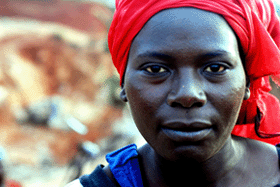 However, a majority of women at the Kireka quarry are eager to go home. Most have large families – of up to four or five children – and want to be able to support them properly. Others miss their former communities and their more familiar lifestyle as small-scale farmers.
However, a majority of women at the Kireka quarry are eager to go home. Most have large families – of up to four or five children – and want to be able to support them properly. Others miss their former communities and their more familiar lifestyle as small-scale farmers.
The future of these women and their children will largely be decided by the Ugandan government and NGOs working and lobbying for refugees. NGOs fear that it will be hard to separate urban IDPs from other quarry dwellers and the government wonders what kind of problems will be created if they launch a resettlement plan: will quarry workers who are not IDPs demand compensation? How can urban IDPs be identified? How much will each resettlement cost? Who will fund the programs?
Okello says that in order for the women and other urban IDPs to receive compensation, the government must first make a clear statement of its position. Under national IDP policies, the government is required to assess and evaluate the situation of urban IDPs.
"What I am trying to say is that the government has a framework for dealing with displacement," concludes Okello, "what is left is implementation."
***
For more information, please lease visit the Women of Kireka blog at http://nuwechi.wordpress.com/
The women are also raising $23,000 to start a tailoring business and get off the rock quarry. You can help them out at the Point: http://www.thepoint.com/campaigns/the-women-of-kireka
Siena Anstis is a Canadian-Swedish freelance journalist who has spent several summers writing from Uganda. Aside from her passion for writing and photography, she’s interested in using journalism to foster positive change and alleviate poverty. All photos by Anstis.
